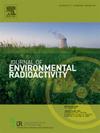天然水体中210Po的测定:三种方法相似结果的比较
IF 2.1
3区 环境科学与生态学
Q3 ENVIRONMENTAL SCIENCES
引用次数: 0
摘要
长期以来,海洋学家一直使用210Po/210Pb不平衡来量化海洋表面颗粒物有机物质的通量。然而,Roca-Martí等人(2021)最近的证据发现,从天然水样中浓缩钋的两种常用方法之一-与Fe(OH)3共沉淀法-导致210Po活性明显低于另一种方法-与Co-APDC共沉淀法。在本研究中,我们采用Roca-Martí等人(2021)使用的两种方法和我们自己改进的Fe(OH)3技术测量了从湖泊、港口、河流和沼泽来源采集的淡水样品中的210Po。我们发现三种方法之间的不显著偏差≤0.5 dpm 210Po 100 L−1。我们没有发现任何证据表明209Po在15分钟内与天然210Po的平衡不像平衡12小时后那样充分。最后,我们没有发现溶解的210Po的有机络合会干扰钋的回收。我们的结果并没有否定Roca-Martí等人(2021)的发现。210Po在海洋系统中的行为可能确实不同。然而,我们建议未来的研究还应研究铁沉淀的收集以及颗粒有机物的组成和浓度如何影响未过滤水样中吸收的210Po的回收率。本文章由计算机程序翻译,如有差异,请以英文原文为准。
Measuring 210Po in natural waters: A comparison of three methods with similar results
Oceanographers have long used 210Po/210Pb disequilibria to quantify flux of particulate organic matter from the surface ocean. However, recent evidence by Roca-Martí et al. (2021) found that one of two commonly used methods to concentrate polonium from a natural water sample – coprecipitation with Fe(OH)3 – resulted in significantly lower 210Po activities than the other method – coprecipitation with Co-APDC. In this study, we employed the two methods used by Roca-Martí et al. (2021) and our own modified Fe(OH)3 technique to measure 210Po in freshwater samples collected from lake, harbor, river, and bog sources. We found a non-significant bias of ≤0.5 dpm 210Po 100 L−1 between all three methods. We found no evidence that 209Po was not as fully equilibrated with natural 210Po in 15 min as it was after 12 h of equilibration. And finally, we found no indication that organic complexation of dissolved 210Po was interfering with polonium recovery. Our results do not negate the findings by Roca-Martí et al. (2021). The behavior of 210Po in marine systems may indeed be different. However, we recommend that future studies also examine how the collection of iron precipitate and the composition and concentration of particulate organic matter might influence the recovery of absorbed 210Po from an unfiltered water sample.
求助全文
通过发布文献求助,成功后即可免费获取论文全文。
去求助
来源期刊

Journal of environmental radioactivity
环境科学-环境科学
CiteScore
4.70
自引率
13.00%
发文量
209
审稿时长
73 days
期刊介绍:
The Journal of Environmental Radioactivity provides a coherent international forum for publication of original research or review papers on any aspect of the occurrence of radioactivity in natural systems.
Relevant subject areas range from applications of environmental radionuclides as mechanistic or timescale tracers of natural processes to assessments of the radioecological or radiological effects of ambient radioactivity. Papers deal with naturally occurring nuclides or with those created and released by man through nuclear weapons manufacture and testing, energy production, fuel-cycle technology, etc. Reports on radioactivity in the oceans, sediments, rivers, lakes, groundwaters, soils, atmosphere and all divisions of the biosphere are welcomed, but these should not simply be of a monitoring nature unless the data are particularly innovative.
 求助内容:
求助内容: 应助结果提醒方式:
应助结果提醒方式:


